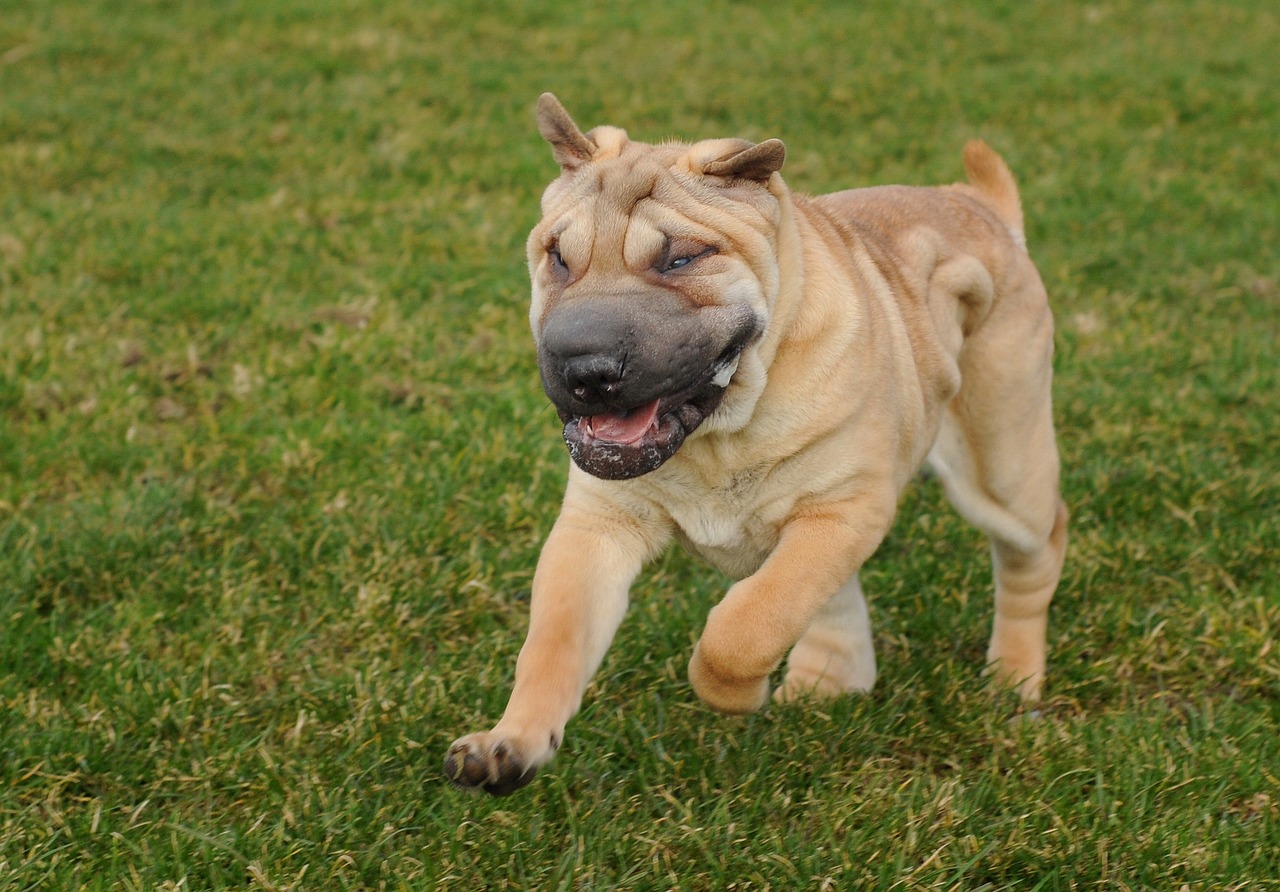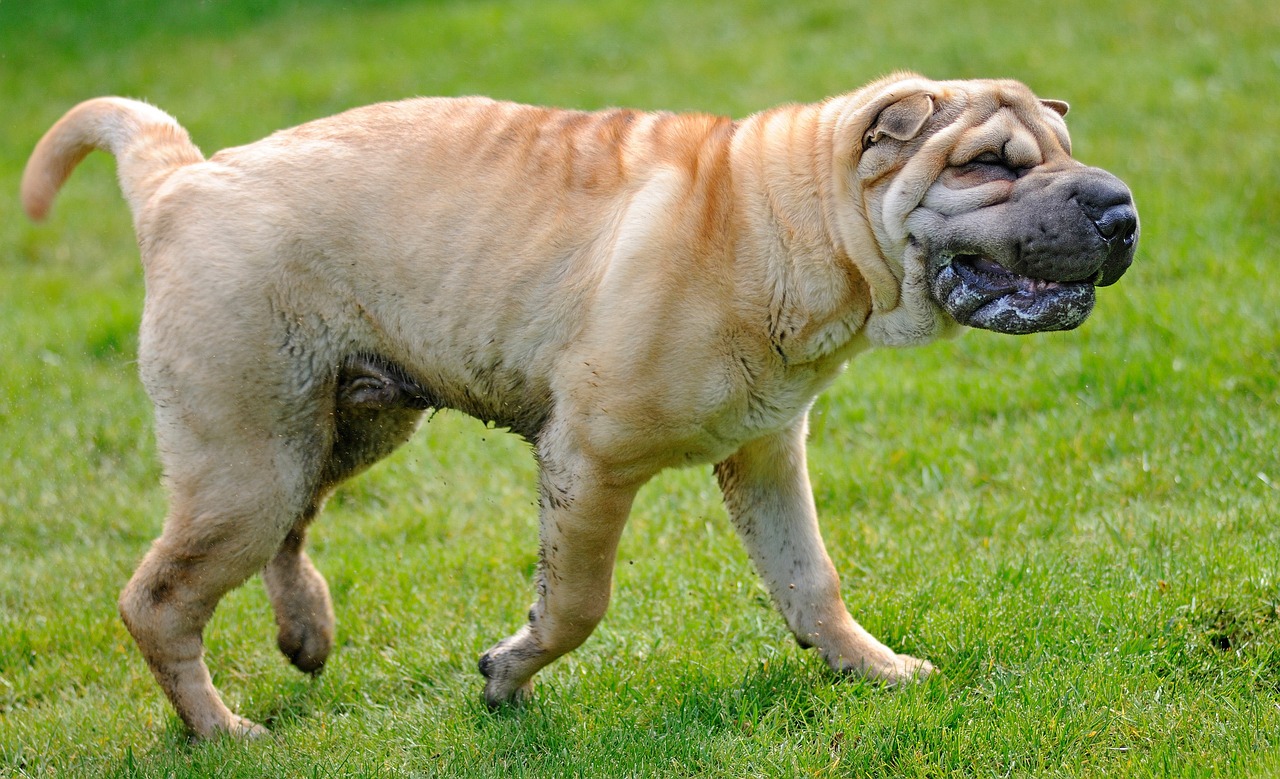1. Where did Shar Peis originally come from?
Shar Peis originate from China, specifically from the southern province of Guangdong. They are one of the world’s oldest dog breeds, with their history tracing back over two thousand years to the Han Dynasty. Ancient Chinese statues and art pieces depict dogs resembling the Shar Pei, indicating their long-standing presence in Chinese culture. Initially, these dogs were bred for various purposes, including hunting, herding, and guarding. Their unique physical characteristics, such as their deep wrinkles and blue-black tongue, were highly valued for both practical reasons in work and as symbols of luck and protection.
2. What does “Shar Pei” mean?
The term “Shar Pei” translates to “sand skin” in Cantonese, a reference to the unique texture of the breed’s short, rough coat. This distinct coat feels somewhat like sandpaper when stroked in the opposite direction of growth. The name not only describes the physical characteristics of the Shar Pei’s coat but also highlights one of the breed’s most recognizable and defining features. This “sand skin” was historically advantageous, providing the dog with a slight edge in escaping the grasp of predators or adversaries during hunts or fights.
3. What were Shar Peis originally bred for?
Shar Peis were originally bred for multiple purposes, including hunting, herding, and guarding property. Their excellent tracking abilities made them valuable hunters, particularly in tracking and hunting wild game in the dense forests of southern China. Additionally, their strong, muscular build and alert nature made them effective guard dogs, protecting homes and livestock. The Shar Pei’s deep wrinkles and loose skin were practical features, helping protect the dog from bites and injuries while working or in combat.
4. How did the Shar Pei almost become extinct?
The Shar Pei faced the brink of extinction in the mid-20th century due to several factors. The establishment of the People’s Republic of China in 1949 led to stringent government policies against dog ownership, which, combined with widespread famine and political upheaval, severely decreased the population of domestic dogs, including Shar Peis. By the 1970s, the breed was considered one of the rarest in the world, with only a few specimens remaining, primarily in Hong Kong and Taiwan.
5. Who was responsible for saving the Shar Pei from extinction?
Matgo Law, a Hong Kong businessman and dog breeder, played a pivotal role in saving the Shar Pei from extinction. In the early 1970s, Law appealed to dog lovers in the United States through a dog magazine, highlighting the breed’s critical situation and asking for help to preserve it. His efforts were met with enthusiasm, leading to the importation of Shar Peis into the U.S. and the establishment of breeding programs aimed at increasing their numbers and genetic diversity. Law’s actions sparked international interest in the breed, ultimately securing its survival.
6. When was the Shar Pei recognized by the American Kennel Club (AKC)?
The American Kennel Club (AKC) officially recognized the Shar Pei in 1992. This recognition was a significant milestone in the breed’s history, marking its transition from near-extinction to becoming a recognized and valued dog breed worldwide. AKC recognition helped standardize the breed, promote responsible breeding practices, and increase its popularity among dog enthusiasts in the United States and globally.
7. What are the unique physical characteristics of a Shar Pei?
Shar Peis are known for their deep wrinkles, which cover their head, body, and particularly their face and shoulders. Another unique characteristic is their blue-black tongue, a feature they share only with the Chow Chow. They possess a short, bristly “sand skin” coat that can come in various colors. Shar Peis have a compact, muscular build, with a broad head, small, triangular ears, and a high-set, curled tail. These distinctive physical traits not only define the breed’s appearance but also serve functional purposes from their origins as working dogs.
8. How did Shar Peis serve in ancient Chinese society?
In ancient Chinese society, Shar Peis served as versatile working dogs. They were employed in hunting due to their keen sense of smell and ability to track game through dense underbrush. Additionally, their muscular build and protective nature made them effective guard dogs, watching over homes and livestock. The Shar Pei’s loyalty and intelligence also made them valued companions. Their unique appearance, particularly their wrinkles, was believed to ward off evil spirits, adding a spiritual significance to their role in Chinese homes.
9. What challenges did Shar Peis face in modern times?
In modern times, Shar Peis have faced challenges related to their health and genetics, partly due to the limited gene pool from which they were revived in the 1970s. The breed is prone to several hereditary health issues, including skin conditions, eye problems, and hip dysplasia. Additionally, the breed’s sudden popularity after its introduction to the West led to irresponsible breeding practices, exacerbating these health issues. Efforts by breed enthusiasts and responsible breeders have focused on improving Shar Pei’s health and genetic diversity.
10. What is the significance of the Shar Pei’s coat?
The Shar Pei’s coat is significant for several reasons. The “sand skin” coat, from which the breed gets its name, provided a practical advantage in ancient times, protecting the dog from the elements and during fights. The coat’s texture is rough and short, standing straight up from the skin, which, combined with the breed’s wrinkles, gives the Shar Pei its distinctive appearance. There are two main types of Shar Pei coats: the horse coat, which is short and bristly, and the brush coat, which is slightly longer and softer. Both types require specific grooming to maintain skin health.
11. How has the Shar Pei’s role changed from ancient to modern times?
From its ancient origins as a versatile working dog in China, the Shar Pei’s role has significantly changed in modern times. While they still retain their protective and loyal nature, making them excellent guard dogs, Shar Peis are now primarily kept as companion animals. Their unique appearance and calm, devoted temperament have made them beloved pets in homes around the world. Despite this shift from working dog to companion, Shar Peis still exhibited the intelligence, independence, and alertness that were valued in their ancient roles.
12. What are the common health concerns for Shar Peis?
Shar Peis are prone to several health concerns, many of which are related to their unique physical characteristics. Skin issues are common due to their deep wrinkles, which can trap moisture and bacteria, leading to infections. They are also susceptible to eye conditions like entropion, where the eyelid rolls inward, irritating. Additionally, Shar Peis can suffer from hip dysplasia, a genetic condition affecting the hip joint, and a fever syndrome known as Shar Pei Fever, which is specific to the breed. Regular veterinary care and responsible breeding practices are crucial to managing these health concerns.
13. What is Shar Pei Fever?
Shar Pei Fever is a hereditary condition unique to the Shar Pei breed, characterized by episodes of fever and swelling of the hocks (the joints on the back legs). These fever episodes can be accompanied by general discomfort and lethargy. The exact cause of Shar Pei Fever is unknown, but it is believed to be related to the breed’s immune system. While there is no cure, the condition can be managed with medication and veterinary care. Owners of Shar Peis should be aware of the symptoms and seek prompt veterinary attention if Shar Pei Fever is suspected.
14. How should Shar Peis be cared for?
Caring for a Shar Pei requires attention to their unique needs, particularly regarding their skin and health. Regular grooming is essential to maintain their coat and prevent skin infections in their wrinkles. It’s important to clean their wrinkles with a damp cloth and keep them dry to avoid irritation. Shar Peis also requires regular exercise to maintain a healthy weight and prevent boredom. A balanced diet, routine veterinary check-ups, and monitoring for signs of common health issues like Shar Pei Fever are crucial to their well-being. Socialization and training from a young age can help manage their independent nature and ensure they are well-adjusted pets.
15. How can prospective Shar Pei owners ensure they’re getting a healthy dog?
Prospective Shar Pei owners should research and choose a reputable breeder who conducts health screenings on their breeding dogs for common genetic conditions associated with the breed. Good breeders will be transparent about the health of their puppies and the health history of the parents. They should provide health clearances and be willing to discuss the measures they take to reduce the incidence of hereditary conditions in their breeding lines. Additionally, prospective owners should ask about the puppy’s socialization, diet, and early veterinary care. It’s also beneficial to visit the breeder, meet the puppy’s parents, and observe the conditions in which the puppies are raised to ensure they are healthy and well-cared for.


 Toledo, United States.
Toledo, United States.